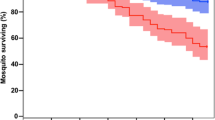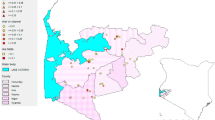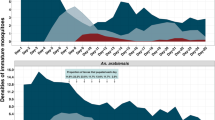Abstract
Simulium, the biting pest and vector of human onchocerciasis, is best controlled by the regular use of larvicides—DDT in particular—in the streams and rivers in which the immature stages develop1. The speed of reinfestation after the application of larvicide suggests that Simulium eggs are not affected by the doses usually applied2. Partly because of the difficulty of finding eggs3, ovicides have never received serious consideration for Simulium control. Because we have repeatedly found egg masses of Simulium ornatum in field breeding streams in Surrey, we have been able to investigate the effects of a range of potential larvicides against eggs in the laboratory. Our findings, with technical details, will be reported fully later, but the following is a summary of our results.
This is a preview of subscription content, access via your institution
Access options
Subscribe to this journal
Receive 51 print issues and online access
$199.00 per year
only $3.90 per issue
Buy this article
- Purchase on Springer Link
- Instant access to full article PDF
Prices may be subject to local taxes which are calculated during checkout
Similar content being viewed by others
References
McMahon, J. P., Bull. WHO, 37, 415 (1967).
Fredeen, F. J. H., Arnason, A. P., Berck, B., and Rempel, J. G., Canad. J. Agric. Sci., 33, 379 (1953).
Hocking, B., Sci. Agric., 30, 489 (1950).
Author information
Authors and Affiliations
Rights and permissions
About this article
Cite this article
MUIRHEAD-THOMSON, R., MERRYWEATHER, J. Effect of Larvicides on Simulium Eggs. Nature 221, 858–859 (1969). https://doi.org/10.1038/221858a0
Received:
Revised:
Issue Date:
DOI: https://doi.org/10.1038/221858a0
Comments
By submitting a comment you agree to abide by our Terms and Community Guidelines. If you find something abusive or that does not comply with our terms or guidelines please flag it as inappropriate.



